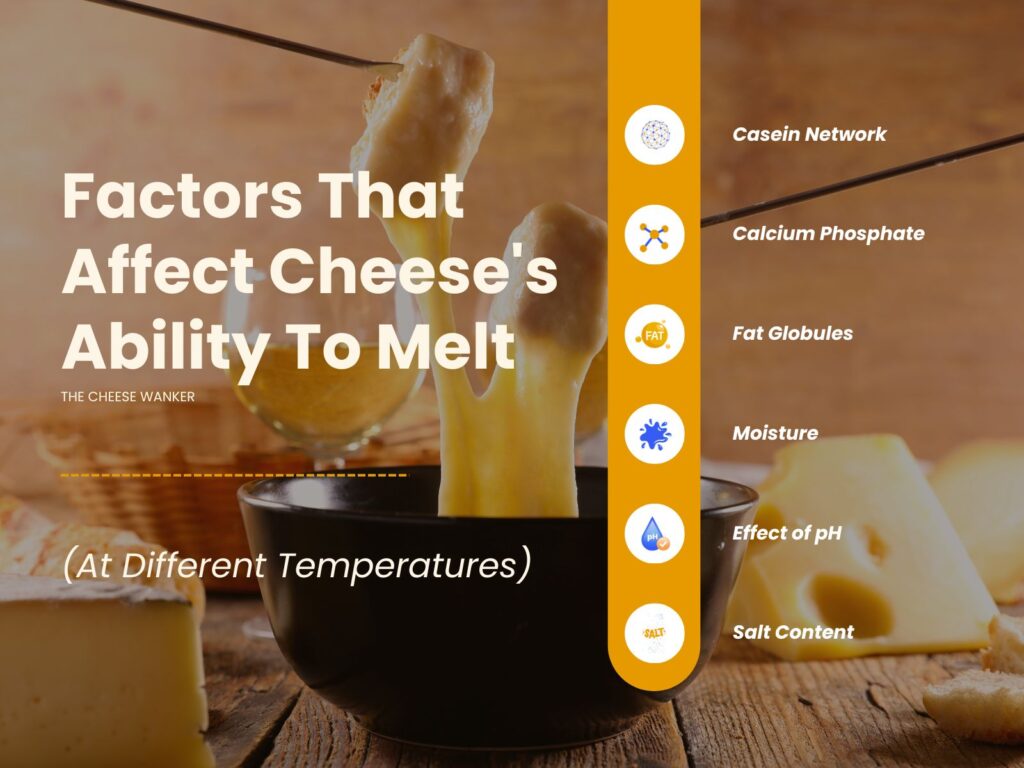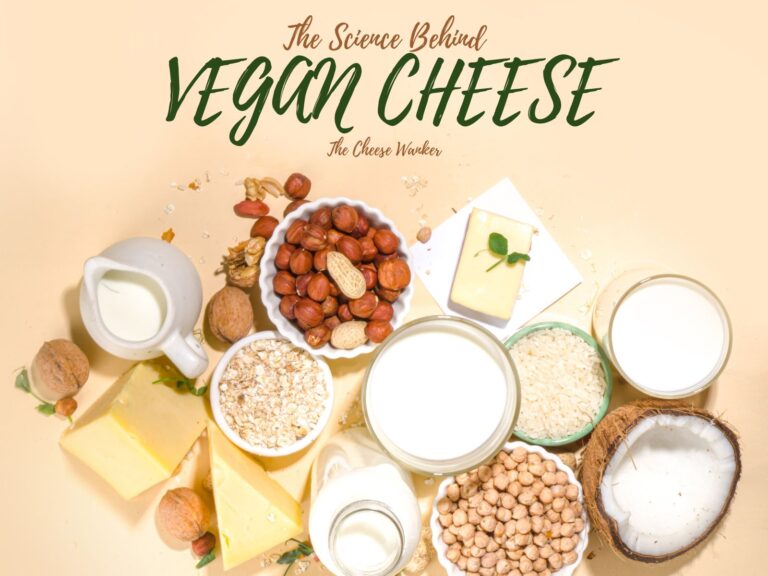Ever marvelled at the mesmerising transformation of cheese into a gooey masterpiece when heated? Join us as we unravel the science behind this culinary magic. From the role of fats and proteins to the effect of moisture and acidity, we demystify the secrets that make it a kitchen favourite. Read on to find out why some cheeses melt when heated.

READ MORE: What are the organoleptic properties of cheese? →
What is cheese made of?
At its core, cheese is a complex interplay of diverse components, each contributing to its unique texture, flavour and melt characteristics. Understanding the composition of cheese is akin to decoding the secrets within its dairy matrix.
Here’s a closer look at the primary constituents that make up this beloved culinary delight:
Casein protein: The backbone of cheese
Casein stands as the major protein found in milk, forming the fundamental structural element of cheese. The casein molecules in cheese often aggregate into micelles or bundles, providing the framework for the cheese matrix.
Fats: Enhancing creaminess and meltability
Next, fats, in the form of triglycerides and fatty acids, contribute to the richness and mouthfeel of cheese. Higher fat content often results in a more indulgent, creamy texture and influences the cheese’s melt and stretch properties.
Carbohydrates: Lactose and beyond
Lactose, a common carbohydrate in milk, plays a role in the flavour profile of cheese. As cheese ages, lactose is gradually converted into lactic acid, influencing both taste and texture.
Minerals: Building strength and flavour
Essential minerals, prominently calcium and phosphate, play a crucial role in fortifying the structure of the casein network. Calcium phosphate, in particular, contributes to the binding of casein aggregates and influences the melt and stretch of cheese.
We’ll take a closer look at this essential “glue” further down.
Water: The fluid medium
Finally, water is a significant component, providing the medium for various chemical reactions and contributing to the overall moisture content of the cheese. The water content influences the cheese’s texture, with lower moisture cheeses often exhibiting less melt.
As these components harmonise, they give rise to the diverse array of cheeses, each with its own distinct personality. The composition of cheese not only dictates its physical attributes but also serves as the canvas upon which the intricate processes of ageing, pH adjustments and coagulation unfold.
Ultimately, these shape the delightful sensory experience we associate with this dairy delicacy.
What does cheese melt mean?
“Cheese melt” refers to the process in which cheese transitions from a solid state to a liquid or semi-liquid state when exposed to heat. This transformation is characterised by the softening and flow of the cheese, resulting in a gooey, molten consistency.
Undoubtedly, melted cheese is a fundamental element in many dishes, ranging from pizzas and sandwiches to fondues and casseroles, where its creamy, savoury and sometimes stretchy qualities enhance the overall culinary experience.
The ability of cheese to melt is influenced by various factors, including its composition, fat content, moisture content, pH and the presence of certain minerals.
Moreover, the melting point and meltability can vary among different types of cheese, each contributing to the unique textures and flavours.
Factors that determine whether a cheese will melt
To comprehend the interactions among caseins that shape meltability in cheese, various factors come into play, each contributing to a complex interplay.
Casein density
Firstly, the ability of cheese to melt gracefully and achieve that coveted gooey texture hinges significantly on the density of casein. Casein, present in the form of micelles or bundles within the cheese matrix, plays a pivotal role in determining how the cheese responds to heat.
Here’s a closer look at how casein density influences a cheese’s ability to melt:
Formation of casein micelles
Casein molecules in cheese aggregate into micelles, forming the structural backbone of the cheese. The arrangement of these micelles determines the overall casein density, impacting the cheese’s response to heat.
Effect on melting point
Higher casein density generally corresponds to a higher melting point for the cheese. This means that cheeses with a denser casein network will require more heat to initiate the melting process compared to cheeses with a lower casein density.
Role in texture and stretch
Furthermore, the density of casein directly influences the texture and stretchiness of melted cheese. A denser casein network tends to result in a more cohesive structure, leading to a cheese that may exhibit a firmer, less stretchy melt.
Cheese varieties and casein density
Different types of cheese exhibit varying casein densities, contributing to the wide spectrum of melt behaviors observed across cheese varieties. For instance, aged cheeses with a denser casein structure might have a more gradual and controlled melt compared to younger, less dense cheeses.
Balancing act
Achieving the optimal casein density is a delicate balance in cheesemaking. Factors such as milk composition, coagulation conditions and ageing play vital roles in determining the density of casein and, consequently, the melt properties of the final cheese product.
Understanding the impact of casein density on a cheese’s ability to melt provides valuable insights for cheesemakers and culinary enthusiasts alike. It emphasises the intricate relationship between the composition of cheese and the heat-induced transformations that result in the delightful, molten consistency we all love.
Casein-calcium phosphate bonds
Central to the meltability of cheese is the intricate dance between casein and calcium phosphate, forming bonds that serve as the architectural foundation of the cheese matrix. These bonds, akin to invisible threads, play a pivotal role in determining how a cheese responds to heat and ultimately melts.
Here’s a closer exploration of the profound influence of casein-calcium phosphate bonds on a cheese’s meltability:
Structural stability
Bound calcium phosphate acts as the glue that binds casein molecules together, forming stable aggregates within the cheese matrix. This structure provides the foundation for the cheese’s physical integrity, influencing its ability to withstand heat without immediate collapse.
Calcium phosphate bridges
The bridges formed by calcium phosphate between casein strands contribute to the strength and resilience of the casein network. These bonds restrain the movement of casein molecules, slowing down the melt process and imparting a more controlled, gradual transformation.
pH-dependent influence
The amount of bound calcium phosphate is pH-dependent. Higher pH levels result in more bound calcium phosphate, leading to a more tightly bound casein network. This can inhibit the ease of melt, resulting in a cheese with a firmer texture.
Controlled melt vs. fluidity
Moreover, the strength of casein-calcium phosphate bonds determines whether the cheese exhibits a controlled melt or a more fluid, rapid transformation. A denser network with stronger bonds tends to melt more slowly, allowing for a more controlled and desirable textural outcome.
Influence on stretch
Casein-calcium phosphate bonds are integral to the stretchiness of melted cheese. As these bonds break and reform during the melting process, they contribute to the characteristic stretch observed in cheeses like Mozzarella, where casein strands pull apart and then reconnect.
Balance in cheesemaking
Achieving the optimal balance of casein-calcium phosphate bonds during cheesemaking is a delicate process. Factors such as pH control, coagulation conditions and ageing duration contribute to finding the right equilibrium, ensuring that the cheese possesses both structural stability and desirable meltability.
Presence of fat globules in cheese structure
The role of fat in cheese melt and stretch is significant. As a general rule, cheeses with higher fat content tend to melt more effortlessly compared to their lower fat counterparts. This is attributed to the fact that fat aids in diluting the casein network.
Effectively, milkfat globules envelop the casein aggregates without interacting with them directly. The presence of milkfat globules serves to separate some of the casein strands, thereby reducing the number of interactions between casein aggregates.
This weakening effect on the casein network results in a cheese that readily melts and stretches, even at cooler temperatures, in contrast to cheeses with lower fat content.
This phenomenon can be observed in soft cheeses like Camembert and Epoisses once they have reached optimal ripeness.
Moisture content in cheese
Also, the amount of moisture within a cheese’s structure is a key determinant of its meltability. For example, higher moisture cheeses, like a young Monterey Jack, will exhibit more melt than a drier, aged version. However, it’s essential to note that increasing moisture doesn’t necessarily guarantee a proportional rise in melt.
Take Cottage Cheese as an example. Despite containing about 80% water, this fresh cheese fails to melt or stretch. The explanation lies in its low pH (around 4.6). At a low pH (<5.0), casein molecules carry equal positive and negative charges, causing them to adhere closely.
And this leads us to the next section.
Effect of pH on cheese melt
Acidity is a crucial factor in determining the melt properties of cheese, as it directly influences the retention of bound calcium phosphate in the casein structure. As we’ve already mentioned, calcium phosphate plays a vital role in “holding” casein aggregates together during the stretching process.
The specific pH at which cheese begins to melt or stretch is contingent on the casein content and the amount of bound calcium phosphate in the casein network.
High pH cheeses (low acidity)
Cheeses with a higher pH, approximately around 6.3, contain more bound calcium phosphate in the casein network. This abundance of bound calcium phosphate causes the caseins to be tightly “glued” together, resulting in reduced melt and stretch.
Examples of cheeses with higher pH values include Juustoleipa (Finnish Bread Cheese), Queso Fresco and Queso Panela.
Mid-range pH cheeses (moderate acidity)
The pivotal role of acidity in cheese melt and stretch becomes evident as the pH decreases, typically within the 5.2-5.4 range. At this point, some calcium phosphate dissolves from the casein network and is replaced by hydrogen ions (H+).
chargThis dynamic interchange creates a balance of bound and unbound calcium phosphate, allowing the cheese to exhibit optimal melt and stretch properties.
Cheeses within the 5.2-5.4 pH range, such as Low Moisture Part Skim Mozzarella, Whole Milk Mozzarella, Colby and Muenster, showcase excellent melt and stretch characteristics.
Low pH cheeses (high acidity)
However, if the acidity drops further to around 4.6, most of the calcium phosphate is dissolved from the casein structure. As mentioned earlier, this dissolution causes the oppositely charged casein molecules to adhere more tightly to each other.
Cheeses with low pH, such as Cottage Cheese, Feta and Cream Cheese, exemplify this phenomenon and tend to lack the desired melt and stretch qualities.
The impact of proteolysis
Proteolysis is the process of breaking down proteins into smaller peptides or amino acids during ageing in cheese. In some cheeses, this breakdown is facilitated by residual rennet or microbial activity.
The consequence of proteolysis is the fragmentation of the casein network, leading to a cheese that readily melts but exhibits limited stretch. It’s important to note that a well-preserved, intact casein network is crucial for the formation of strands necessary for good stretch.
To control proteolysis, the use of less coagulant can slow down the process, minimising residual rennet. In the production of cheeses like Parmigiano Reggiano or Gruyère, higher cooking temperatures can be employed to deactivate some of the coagulant.
Certain cheeses intentionally undergo extensive proteolysis, such as mould or surface-ripened varieties. After ageing, these cheeses possess the ability to melt and flow at room temperature. However, their casein network is too extensively broken down to allow for proper stretching, highlighting the delicate balance between proteolysis and cheese texture.
The two examples we mentioned earlier in relation to fat content (Camembert and Epoisses) are also relevant here. As a result of continued proteolysis and high fat content, these two cheeses will often ooze at room temperature.
What buffering does to cheese melt
Beyond proteolysis, another crucial process during cheese ageing is buffering. Buffering occurs when bound calcium is replaced with hydrogen ions (H+) and the hydration of the casein takes place. This phase may span several days, during which the pH of the cheese increases or “buffers up”.
The loss of bound calcium phosphate in the casein is pH-dependent, meaning that the lower the pH of the cheese, the faster the hydration, leading to rapid changes in melt properties. This buffering process is particularly significant for enhancing melt and stretch in very young cheese.
The extent of calcium phosphate loss also hinges on the pH at specific stages, such as the pH of the milk at set and the pH of the cheese at drain. Lower pH values at these steps result in less bound calcium.
Salt content in cheese
Salt, a seemingly simple ingredient, plays a multifaceted role in the world of cheese, extending its influence beyond flavour enhancement to crucially impact the meltability of the final product.
Firstly, salt reduces the hydration of the casein network. In doing so, it can increase the amount of bound calcium within the cheese’s structure. As a result, cheeses that are high in salt tend to be firmer and are less likely to melt when heated.
Moreover, salt can inhibit proteolysis in cheese. Proteolysis is a natural ageing process in cheese. This effect, combined with a strengthening of the casein network, can contribute to a lack of melt and stretch in salty cheeses.
Some examples of cheeses that exhibit this trait are Parmigiano Reggiano, Grana Padano and Sbrinz.
Conclusion
In the fascinating world of cheese, the ability of this dairy delight to gracefully transform into a luscious, molten state is a captivating journey influenced by a symphony of factors. From the delicate dance of casein-calcium phosphate bonds to the nuanced interplay of pH, fat content and salt, every element contributes to the final act—the melt.
Cheese meltability is not a one-size-fits-all phenomenon. From the elastic stretch of Mozzarella to the slow, controlled melt of a young Gouda, each cheese variety tells its own story shaped by the careful consideration of these factors during the cheesemaking process.
So, the next time you enjoy that perfectly melted slice of pizza or an expertly crafted grilled cheese sandwich, know that it’s not just heat at work. It’s the culmination of a myriad of scientific nuances, an alchemy that transforms a solid block into a creamy, irresistible indulgence.
As cheese aficionados, chefs and cheesemakers alike, let’s continue to explore the depths of cheese science, experimenting with variables, refining techniques and revelling in the delightful outcomes that arise from this fascinating interplay of factors.
After all, the art of cheesemaking is a journey that promises not just delectable bites but a continuous exploration of the limitless possibilities within the melting pot of cheese science.
References
Journal of Dairy Science: Structure-function relationships in cheese
J.A. Lucey, P.F. Fox: Importance of Calcium and Phosphate in Cheese Manufacture
M. Johnson: The Melt and Stretch of Cheese Winter 2000, Volume 12, Number 1
P. Polowsky: Melt and Stretch 9/20/2021
Woodhead Publishing Series in Food Science, Technology and Nutrition: Cheese Problems Solved: Salt in Cheese



